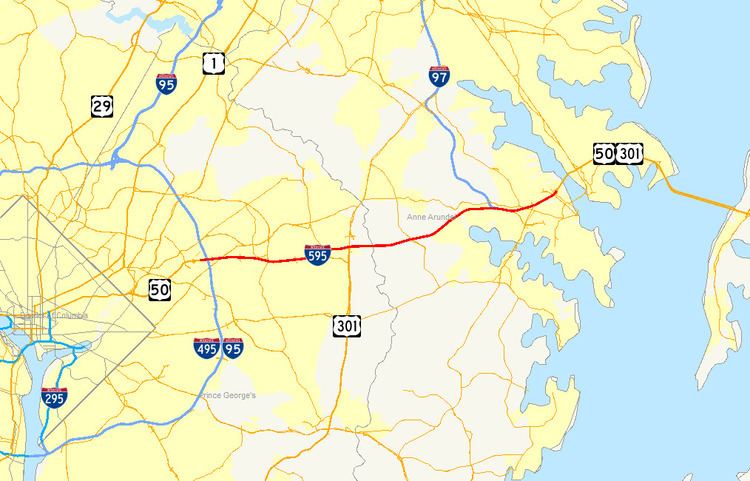I-197 MD 197 → | Length 32.14 km | |
 | ||
West end: I-95 / I-495 / US 50 near New Carrollton East end: US 50 / US 301 / MD 2 / MD 70 in Annapolis Major cities Annapolis, Washington, D.C. Counties Prince George's County, Maryland, Anne Arundel County, Maryland | ||
Interstate 595 (I-595) is an unsigned number for a section of the John Hanson Highway (US 50 and US 301) from I-495 (Capital Beltway) east of Washington, D.C., to Route 70 (Rowe Boulevard) at Annapolis, Maryland.
Contents
- Map of I 595 Maryland USA
- Route description
- Original construction
- Upgrades
- Reasons for lack of signage
- Exit list
- References
Map of I-595, Maryland, USA
US 50/I-595 has a high-occupancy vehicle lane (HOV) in each direction from west of the Beltway to east of US 301, a distance of 8 miles (13 km). Unlike other HOV lanes in the Washington metropolitan area, which are only restricted during rush hours, the HOV lanes on I-595 are restricted at all times.
At 19.97 miles (32.14 km) long, I-595 is the longest unsigned stretch of Interstate Highway in the entire Interstate system. This Interstate was left unsigned because most motorists were already familiar with US 50 and US 301.
Route description
The existing US 50 freeway east from the Baltimore-Washington Parkway converts into I-595 within the Capital Beltway interchange. East of the interchange, I-595 is 10 lanes wide; beyond the Maryland Route 704 (MD 704) interchange, it narrows to eight lanes, with the innermost two being HOV lanes.
The frequency of the interchanges decreases as the development backs away from the highway, and US 50 passes over or under several routes before interchanging with MD 197 near Bowie, using a partial cloverleaf interchange. The highway approaches a residential development as it soon after interchanges with the next major route: US 301 and MD 3. Within this interchange, US 301 joins the freeway, creating a three-route concurrency, and the highway exits development again, traveling through mostly woodland.
Up to and slightly beyond the US 301/MD 3 interchange, the highway surface of I-595 is concrete. From there onwards, the highway is surfaced with asphalt composite. Within the US 301 interchange, the HOV lanes that began at the Capital Beltway come to an end.
There is an interchange with MD 424 in the countryside after turning northwest once more, approaching Annapolis. Before the Annapolis exits, however, US 50 has an interchange with the southern end of I-97. I-97 uses a directional-T interchange, but then the two highways straddle US 50 as collector-distributor lanes, before passing over the highway with another partial interchange and going south into Annapolis as a direct freeway spur, now signed as MD 665.
After the collector-distributor roads leave, the highway passes through the Annapolis urban area, and interchanges with MD 450. MD 450 is an older alignment of US 50, which runs parallel to the John Hanson Highway between Annapolis and Washington. Shortly after this, I-595 meets Medical Parkway and Solomons Island Road. Solomons Island Road adds one more highway to the concurrency: MD 2. The four-route concurrency of I-595, US 50, US 301, and MD 2 continues until the next interchange only about a mile later at MD 70, also called Rowe Boulevard, which leads to downtown Annapolis. Here, the John Hanson Highway name ends, as does I-595. US 50, US 301, and MD 2 continue along the freeway routing, no longer a part of the Interstate Highway System. However, the physical roadbed was fully upgraded to Interstate Highway standards to the western edge of the Severn River Bridge.
Original construction
The John Hanson Highway, US 50's route between Washington, D.C., and Annapolis, was constructed in 1957, and ran from New York Avenue just outside Washington, D.C., to MD 2, the Ritchie Highway, north of Annapolis, connecting to the western approach to the Chesapeake Bay Bridge. The highway was four lanes throughout, and connected to the Baltimore-Washington Parkway, I-495 and US 301 with full-cloverleaf interchanges.
Upgrades
In the 1980s, the John Hanson Highway was planned to be designated as a part of I-97 between the Capital Beltway and the current I-97 interchange and as Interstate 197 between I-97 and MD 70.
In the early 1980s, the I-595 route number was proposed for a connector in Baltimore from I-95 to what was then called I-170, which was left stranded from the rest of the Interstate Highway System by the cancellation of I-70 within the city limits of Baltimore. That connector was never built, and I-170 has been redesignated as part of US 40.
Due to the increasing use of the highway and the dangerous conditions at the interchanges with the Capital Beltway and US 301, the highway was reconstructed to Interstate standards between 1990 and 1995 between the Capital Beltway and MD 70 in Annapolis. Funding for the project was released from the cancellation of Interstate Highway segments within Baltimore. Originally, planners intended to designate the reconstructed highway as I-68, but with the completion of the National Freeway in far western Maryland in 1991, the Maryland State Highway Administration chose instead to designate that route as I-68, leaving the John Hanson Highway to be designated as I-595.
Reasons for lack of signage
In January 2001, highway historian Scott Kozel contacted the Maryland State Highway Administration (MDSHA) to ask why I-595 was not signed. They responded with: "We did not feel that either the posting in the field or the noting on a map would serve any useful purpose for the traveling public".
At times in 2011, the MDSHA has used the I-595 reference on the CHART website. This seems to be at the discretion of the operator at the time when referencing accidents and incidents on that highway. No official policy change has been mentioned regarding this.
Exit list
Because I-595 is an unsigned route that is completely concurrent with US 50, the latter's exit numbers are used.
